
May 18, 1942
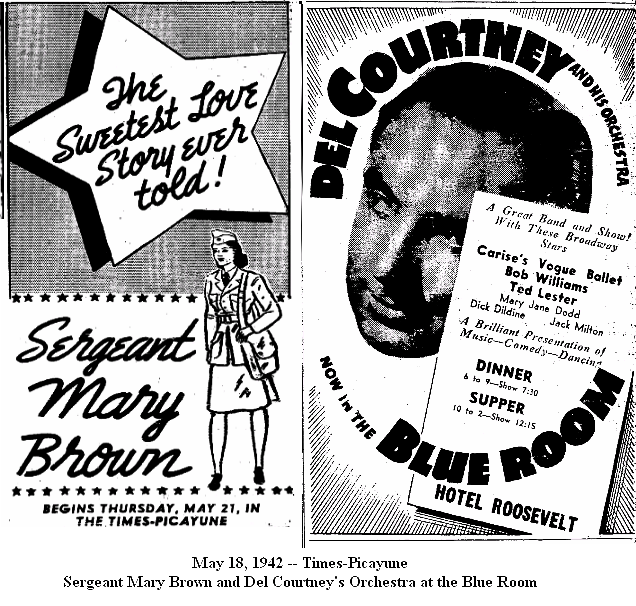
During World War II, the May 18, 1942 Times-Picayune edition included this advertisement for "The
Sweetest Love Story Ever". The May 20 edition also alerted readers of this upcoming "exciting new story right
out of today's headline. The story of a much too pretty army hostess and a far too lonesome soldier boy". Mary
Lee Brown was the heroine of Louis Holmes' fictional love story, which ran as a series from May 21 until June 25, 1942 in
the Picayune. Syndicated to newspapers around the country by NEA Service, Inc. (which later to become Newspaper Enterprise
Association), Sergeant Mary Brown was a seemingly wealthy young woman who owned and flew her own plane, was chauffeured around
by a personal driver, and volunteered as a hostess at an army camp. She was neither a sergeant nor wealthy (her father
went "broke" just a few days into the series). Pressured by her family to marry a rich man who prospectively
might dole them out of the poorhouse, Mary Lee chose love over money and fell in love with a regular "Joe".
Del Courtney (whose orchestra was engaged at the Blue Room o this day in
1942) was born on September 24, 1910 in Oakland, California, as Delmore Anthony Courtney. He was an actor, known for Breakin'
It Down (1946), Del Courtney and His Orchestra (1949) and Swing's the Thing (1942). He was married to Connie Haines [who performed
with Frank Sinatra in both the Harry James and Tommy Dorsey bands] and Yvonne King [of the King Sisters]. Courtney died on
February 11, 2006 in Honolulu. (From http://www.imdb.com/name/nm0183907/bio)
You Can Support this Site by Clicking on & Shopping from this Amazon Link -- and it
won't cost you a penny more:


LSU's tiger mascot Mike V was born on October 19, 1989. The 7-pound baby tiger was introduced
to LSU fans at a basketball game in February 1990. In his 17-year reign, Mike V saw an LSU football team win another National
Championship (in 2003) and received both a new trailer and a massive renovation of his enclosure. In March 2007, Mike
V officially began a three-stage retirement. His personal veterinarian, David Baker, cited his age and health as reasons.
Mike V retained his mascot status and lived in his on-campus habitat until his death by renal failure on May 18,
2007 at 2:23 AM, which coincided with the undergraduate commencement ceremonies. He was considered to have had the
best personality of all the tigers that have served as LSU's mascot. Originally named Stevie, he was donated by Dr. Thomas
and Caroline Atchison of the Animal House Zoological Park in Moulton, Alabama. (From http://en.wikipedia.org/wiki/Mike_the_Tiger)
On May 18, 1959, the song Battle Of New Orleansby Johnny Horton became the number-one
country single.
Joe Brown, born on May 18, 1926 in Baton Rouge, was the undisputed Lightweight
Championship of the World in 1956, a tiltle he held 11 times until losing to Carlos Ortiz in 1962. Known as the ‘Creole
Clouter’ and Joe ‘Old Bones’ Brown, he was managed by Lou Viscusi and named The Ring's 'Fighter of the Year'
for 1961. Brown was inducted into the International Boxing Hall of Fame in 1996. In his later years he was a trainer in New
Orleans and died in New Orleans on December 4, 1997 at age 71.
Homer Plessy, a New Orleans man who represented a group of citizens challenging the segregation
of public facilities claimed that it was unconstitutional and that it violated the rights set forth in the 14th Amendment.
Four years after its initial hearing in Louisiana, the case of Plessy vs. Ferguson went before the United States Supreme Court
which was then located in the Cabildo. In a landmark decision handed down on May 18, 1896, the Court upheld
the Louisiana statute, thereby making the doctrine of 'separate but equal' the law of the land for nearly 60 years, until
it was overturned in 1954 in Brown v. Topeka Board of Education.
A New York Times report of May 18, 1874 included this information about a duel in New
Orleans (in what is now City Park): “...surgeons met and after the usual preliminaries both took their positions. As
they put themselves en garde they were calm and collected...They got to work...and rattle of the foils made the scene dramatic
in the extreme. Mr. Laversche was wounded in the stomach and Mr. Grandjean in the shoulder...A parley was held, and the friends
of both parties being satisfied, the wounded men left their posts...The cause of the difficulty was a dispute a few nights
ago in a club-room about some private matter...Both gentlemen are doing well today, and their hurts will only inconvenience
them for a short time”. Mr. Grandjean was about 18 years old at that time but sixty-four years later a plaque was placed
on a bridge in City Park reading, “MEMORIAL TO GEORGE H. GRANDJEAN C.E. [Civil Engineer] PARK COMMISSIONER 1892—1900
DESIGNER OF ORIGINAL LAGOONS”. Grandjean also served as United States Deputy Land Surveyor. ( #158cp)
NICHOLSON, Eliza Jane Poitevent Holbrook, poet, newspaper proprietor. Born, near Pearlington, Miss.,
March 11, 1849; daughter of lumberman William James Poitevent and Mary Amelia Russ. Fifth of eight children, but lived
with an uncle and aunt, the Leonard Kimballs, as a result of mother's ill health. Grew up on their farm near the Pearl
River where her love of nature was reflected in poetry writing by age fourteen. Education: at home; Amite Female Seminary.
Using the name "Pearl Rivers," sent work to John W. Overall, editor of The South. His encouragement led to the
submission of poems to such publications as the Home Journal in New York and the Daily Picayune and the Times in New Orleans.
Poems appeared in an anthology by 1869. In 1870 accepted the post of literary editor of the Daily Picayune. On May
18, 1872, married the owner of the Picayune, Alva Morris Holbrook (q.v.), forty-one years older than Eliza. After
his death in January, 1876, took over the joint position of editor-publisher and brought the paper from bankruptcy to financial
success within the next twenty years. Married the business manager of the paper, George Nicholson (q.v.), a native of England,
thirty-one years her senior, on June 27, 1878. Children: Leonard Kimball (b. 1881) and Yorke Poitevent (b. 1883). As
editor-publisher of the Daily Picayune, turned the paper into a family publication featuring the society page, a young people's
section, comics, household and medical columns, advice to the lovelorn, and a literary section. Also championed such civic
causes as free night schools and humane treatment of animals. Served as president of the Women's National Press Association
in 1884. Publication: Lyrics, a selection of poems (1873). Died, February 15, 1896, from influenza, ten days after the
death of second husband; interred Metairie Cemetery, New Orleans, La. J.J.J. Sources: Thomas E. Dabney, One Hundred Great
Years (1944); James H. Harrison, Pearl Rivers, Publisher of the Picayune (1932); Notable American Women, 1607-1950, 3 vols.
(1971); and New Orleans Daily Picayune, February 16, 1896. From http://lahistory.org/site.php?pageID=31
ARPIN, Paul, journalist. Born in
France, 1811; arrived in New Orleans where he wrote a literary column for L'Abeille, 1839-1840. Editor of the French section
of L'Abeille, 1845-1848. Went to New York as editor of Le Courrier des Etats-Unis, until 1853. Founded Le Progrès
in New York, 1855. Wrote Biographie de L. M. Gottschalk, pianiste américain (1853). Contributor to American Cyclopaedia.
Died, New York, May 18, 1865. M.A. Sources: Ed-ward Larocque Tinker, Les Ecrits de langue française
en Louisiane au XIXe siècle (1932); Auguste Viatte, "Com-plément à la bibliographie Edward Larocque
Tinker," Revue de Louisiane, III (1974); Charles Testut, Portraits lit-téraires de la Nouvelle-Orléans
(1850); Appleton's Cyclopaedia of American Biography (1900). From http://lahistory.org/site18.php
After John McDonogh purchased the property which would become City Park in 1845 he allowed former owner Louis Allard
to live the remainder of his life there. It is often said that he was buried in a quiet spot under a favorite tree, the Dueling
Oak. However, St. Louis Cathedral records indicate that Allard was buried on May 18, 1847 in St. Louis
Cemetery #2. (LOC) #030c
Basin
Street 'Improvement' Progect
May
18, 1955
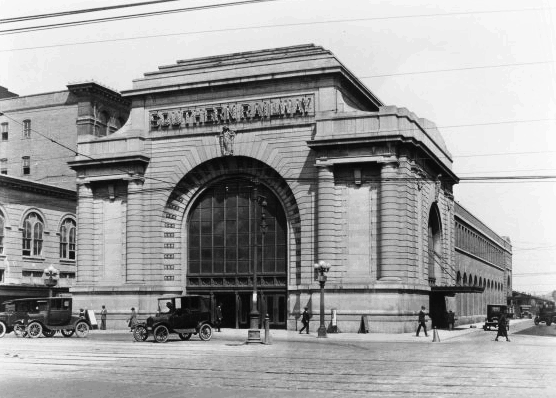
Mayor deLesseps S. Morrison's vision for New Orleans was one of a modernistic 'prgressive' hub of business activity.
He saw other cities grow by leaps and bounds after tearing down the old and bringing in the new and he envisioned the same
for our town. Morrison's administration changed the footprint of New Orleans irrevocably. One example was the demolition
of the Southern Railroad Terminal, also known as the Terminal Station, which was constructed at 1125 Canal at Basin Street
in 1908. The building was designed by Daniel Burnham, the architect for Washington D.C.'s Union Station.
The station served the Southern Railway's subsidiaries, the New Orleans and Northeastern Railroad Company
and the New Orleans Terminal Company. In the 1940's, the station's signature train was "The Southerner," which
departed New Orleans daily for the east coast. But in the 1950s, Morrison had plans for a modern new train station,
the Union Passenger Terminal on Loyola Avenue, so the railroad abandoned the old Terminal Station. The circa 1920s photo on
the right shows the old station, with Krauss Department Store to the left. Krauss' is now a condominium development.
In 1954, the railroad tracks and the terminal were removed. The caption
for the July 20, 1954 photo below reads: Basin St., status of work, old Southern Railway Terminal, toward Municipal Auditorium.
Widening of Basin Street from Iberville to Orleans is underway in connection with the city's program of providing an expressway
from the Union Passenger Terminal to the Municipal Auditorium. The street will be widened 11 feet on each side to provide
double 44-foot roadways. The city is preparing to buy the old Southern railway station so that the block from Canal to
Iberville can be similarly widened." [Photograph by "Cole" Coleman, for Public Relations Office, City
Hall]. In November 1954, a $1.1 million bond issue allowed for the purchase of the station and the land.
Morrison also sought to expand business relations between New Orleans and
Latin American countries. As component of his city-wide "beautification project" he wanted the city to buy
the old station and replace it with a park-like setting on the neutral ground at Basin and Canal which would include a 12
foot statue of Latin American hero Simon Bolivar.
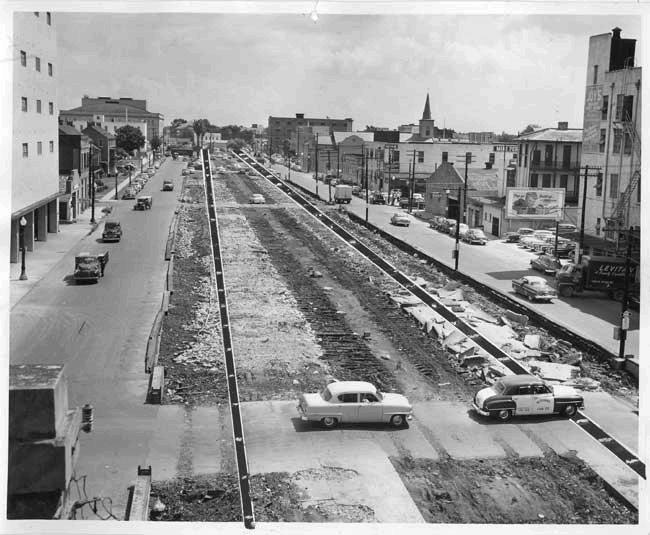
While no documentation exists that New Orleans had strong ties
to Bolivar or that he ever visited our city, Morrison was steadfast in his conviction that Bolivar should be honored in the
"Garden of the Americas" -- a location that some have called "The Gateway to Storyville".
On Wednesday, May 18, 1955 at 7:15 p.m., with much ceremony, Morrison flipped the switch of modernistic mercury
vapor lights which shined down on the newly completed Basin Street beautification and widening project. The New
Orleans Police Department band played Basin Street Blues. City Councilman James E. Fitsmorris was the master of ceremony.
City Council president Glen P. Clasen, who was also the supervisor and treasurer of Krauss Company was there representing
both the city and the retail merchants bureau of the Chamber of Commerce. Reverend Joseph F. Laux led the invocation and Reverend
George H. Wilson did the benediction. New Orleans Jazz Club president George Blanchin spoke. The statue wasn't there.
Morrison spoke of the "ending of one era in our city's
history and we think, the beginning of a new one". Fitzmorris noted that the $1.1 million project was "another
milestone in the growth of our city" adding that Basin Street is "perhaps themost famous street in the world"
because it was "the birthplace of jazz". Blanchin contradicted the "birthplace of jazza' statement but
noted that LuLu White's famous house of prostitution had been demolished in 1949 and replaced with Krauss Department Store's
parking garage. He said "I hope very soon that our city fathers will see fit to erect a suitable monument or marker
in Basin Street in honor of the jazz musicians who did so much for New Orleans".
On June 20, 1955, Blanchin announced a nation-wide competition for the design of monument to jazz which would
be placed on Basin at Canal Street. He said, "Surely jazz is more important in the history of New Orleans than
a Latin American who never had anything to do with the city". Morrision had said "A suitable headstone or
monument" to jazz would be placed on Basin Street but Blanchin feared that it would be dwarfed they the Bolivar statue
and by others proposed for what was now being called the "Parkway of the Americas" (in 1965 a statue of Benito Juarez
of Mexico was added, as was one of . In 1966 Francisco Morazan of Honduras in 1966).
Much discussion
ensued. On July 12, 1955, Morrison said "We assured the Jazz Foundation [New Orleans Jazz Club] a few months ago [at
the lighting ceremony] there would be a monument to jazz on the street and it is a definite plan of the city".
L.A. Riley wrote, and his letter was published in the paper on July 17, 1955. He recounted personal memories
of Milneburg's long pier stretching from the original shore to the lighthouse with its walkways to many camps and clubhouses
where jazz parties were "all conducted by very respectable people. He contended that while jazz was played on Basin Street
it was born in Milneburg and that that Milenburg Joys (not Basin Street Blues) should be the "New Orleans anthem".
Riley suggested that a monument to jazz placed, not on Basin Street but "where Milneburg once stood at Pontchartrain
Beach between the lighthouse and former shoreline. The same day Riley's letter appeared so did one from Blanchin which stated
that the non-profit New Orleans Jazz Club, formed in 1948, supported Morrison's Basin Street monument site.
On
July 21, 1955, the editor of the Picayune opined that a panel of jazz historians could best choose the location and wording
for a monument and ended with "Take it easy", regarding the furor the issue had caused. The following day,
William Dane's letter appeared (on July 22, 1955) suggesting that, instead of Bolivar, the statue of assassinated police chief
David Hennessy should be transplanted from Metairie Cemetery. August 1, 1955 brought a letter from J.F.O. who claimed he
had played music for 35 years, thought a monument to jazz was a good idea, and stated "I never heard of Simon Bolivar",
which was likely the sentiment of many other New Orleanians.
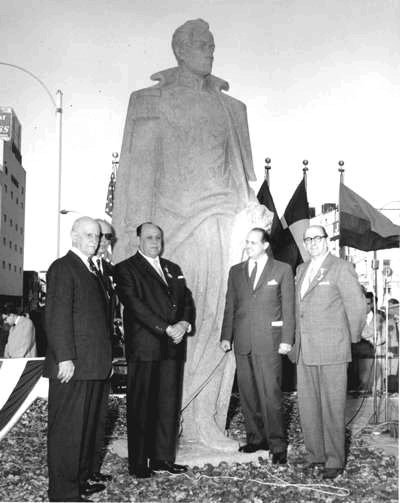
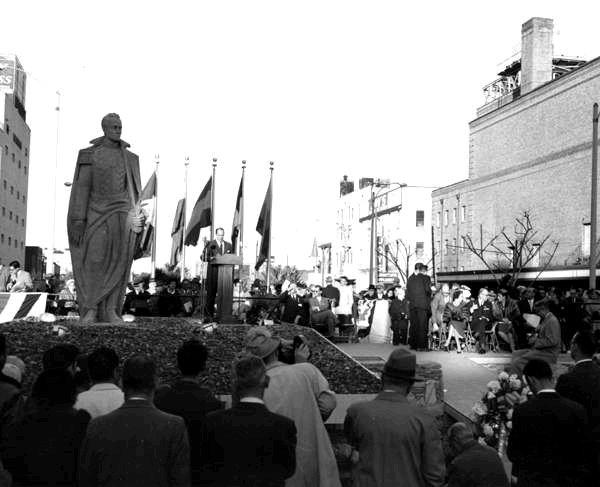 Despite the hoopla, the name for Basin Street's neutral ground as "Garden of the Americas" was officially adopted
via a city ordinance on April 14, 1957. On Monday, May 6, 1957, a "Parade of Progress" ambled 22 blocks from the
Municipal Auditorium to Basin Street at Canal where ground was broken for the plaza that would contain Simon Bolivar's giant
likeness. The Tulane band played for guests from South and Central America. The first shovel of dirt was turned by Francisco
Pacanins, Consul General of Venezuela, whose country provided $350.00 for the monument. The parade then proceeded to
the New City Hall which officially opened that day. And finally, on Monday November 25, 1957, the seven-ton, 12 foot-tall,
granite statue of Simon Bolivar was unveiled. on the Basin Street neutral ground.
Despite the hoopla, the name for Basin Street's neutral ground as "Garden of the Americas" was officially adopted
via a city ordinance on April 14, 1957. On Monday, May 6, 1957, a "Parade of Progress" ambled 22 blocks from the
Municipal Auditorium to Basin Street at Canal where ground was broken for the plaza that would contain Simon Bolivar's giant
likeness. The Tulane band played for guests from South and Central America. The first shovel of dirt was turned by Francisco
Pacanins, Consul General of Venezuela, whose country provided $350.00 for the monument. The parade then proceeded to
the New City Hall which officially opened that day. And finally, on Monday November 25, 1957, the seven-ton, 12 foot-tall,
granite statue of Simon Bolivar was unveiled. on the Basin Street neutral ground.
The Bolivar
statue created by Abel Vallmitjana features five bronze emblems, detailing the five Bolivian coats of arms. Seven flagpoles,
six of which represent the countries Bolivar liberated in the early 1800s stand behind him
Pictured from left to right are Adolfo E. Hegewisch, Chairman of the Bolivar Monument Committee and president
of the Bolivarian Society of Louisiana; Dr. Cesar Gonzalez, Venezuelan ambassador in the United States; Dr. Pedro Gutierrez-Alfaro,
Venezuelan Minister of Health and Welfare; Mayor deLesseps S. Morrison; and Francisco Pacanins, Consul General of Venezuela
in New Orleans.
Photos from the New Orleans Public Library.








 Mayor deLesseps S. Morrison's vision for New Orleans was one of a modernistic 'prgressive' hub of business activity.
He saw other cities grow by leaps and bounds after tearing down the old and bringing in the new and he envisioned the same
for our town. Morrison's administration changed the footprint of New Orleans irrevocably. One example was the demolition
of the Southern Railroad Terminal, also known as the Terminal Station, which was constructed at 1125 Canal at Basin Street
in 1908. The building was designed by Daniel Burnham, the architect for Washington D.C.'s Union Station.
Mayor deLesseps S. Morrison's vision for New Orleans was one of a modernistic 'prgressive' hub of business activity.
He saw other cities grow by leaps and bounds after tearing down the old and bringing in the new and he envisioned the same
for our town. Morrison's administration changed the footprint of New Orleans irrevocably. One example was the demolition
of the Southern Railroad Terminal, also known as the Terminal Station, which was constructed at 1125 Canal at Basin Street
in 1908. The building was designed by Daniel Burnham, the architect for Washington D.C.'s Union Station. 

 Despite the hoopla, the name for Basin Street's neutral ground as "Garden of the Americas" was officially adopted
via a city ordinance on April 14, 1957. On Monday, May 6, 1957, a "Parade of Progress" ambled 22 blocks from the
Municipal Auditorium to Basin Street at Canal where ground was broken for the plaza that would contain Simon Bolivar's giant
likeness. The Tulane band played for guests from South and Central America. The first shovel of dirt was turned by Francisco
Pacanins, Consul General of Venezuela, whose country provided $350.00 for the monument. The parade then proceeded to
the New City Hall which officially opened that day. And finally, on Monday November 25, 1957, the seven-ton, 12 foot-tall,
granite statue of Simon Bolivar was unveiled. on the Basin Street neutral ground.
Despite the hoopla, the name for Basin Street's neutral ground as "Garden of the Americas" was officially adopted
via a city ordinance on April 14, 1957. On Monday, May 6, 1957, a "Parade of Progress" ambled 22 blocks from the
Municipal Auditorium to Basin Street at Canal where ground was broken for the plaza that would contain Simon Bolivar's giant
likeness. The Tulane band played for guests from South and Central America. The first shovel of dirt was turned by Francisco
Pacanins, Consul General of Venezuela, whose country provided $350.00 for the monument. The parade then proceeded to
the New City Hall which officially opened that day. And finally, on Monday November 25, 1957, the seven-ton, 12 foot-tall,
granite statue of Simon Bolivar was unveiled. on the Basin Street neutral ground. 
